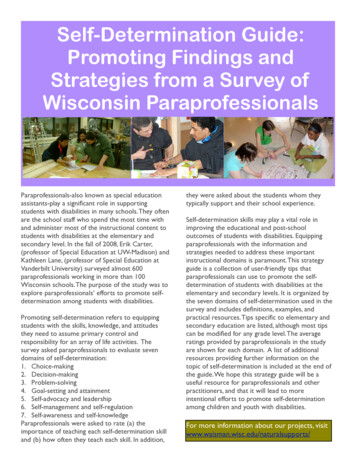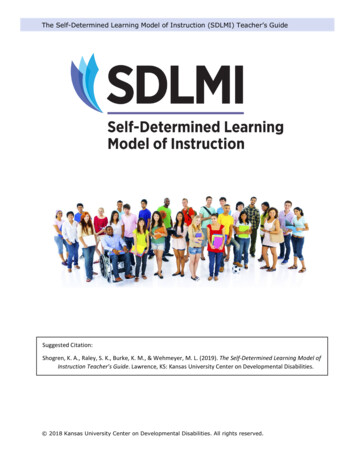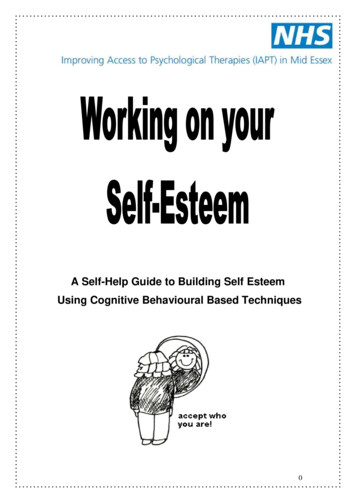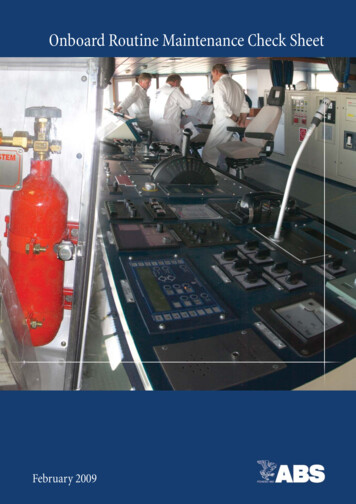
Transcription
Self-Determination Guide:Promoting Findings andStrategies from a Survey ofWisconsin ParaprofessionalsParaprofessionals-also known as special educationassistants-play a significant role in supportingstudents with disabilities in many schools. They oftenare the school staff who spend the most time withand administer most of the instructional content tostudents with disabilities at the elementary andsecondary level. In the fall of 2008, Erik Carter,(professor of Special Education at UW-Madison) andKathleen Lane, (professor of Special Education atVanderbilt University) surveyed almost 600paraprofessionals working in more than 100Wisconsin schools. The purpose of the study was toexplore paraprofessionals’ efforts to promote selfdetermination among students with disabilities.Promoting self-determination refers to equippingstudents with the skills, knowledge, and attitudesthey need to assume primary control andresponsibility for an array of life activities. Thesurvey asked paraprofessionals to evaluate sevendomains of self-determination:1. Choice-making2. Decision-making3. Problem-solving4. Goal-setting and attainment5. Self-advocacy and leadership6. Self-management and self-regulation7. Self-awareness and self-knowledgeParaprofessionals were asked to rate (a) theimportance of teaching each self-determination skilland (b) how often they teach each skill. In addition,they were asked about the students whom theytypically support and their school experience.Self-determination skills may play a vital role inimproving the educational and post-schooloutcomes of students with disabilities. Equippingparaprofessionals with the information andstrategies needed to address these importantinstructional domains is paramount. This strategyguide is a collection of user-friendly tips thatparaprofessionals can use to promote the selfdetermination of students with disabilities at theelementary and secondary levels. It is organized bythe seven domains of self-determination used in thesurvey and includes definitions, examples, andpractical resources. Tips specific to elementary andsecondary education are listed, although most tipscan be modified for any grade level. The averageratings provided by paraprofessionals in the studyare shown for each domain. A list of additionalresources providing further information on thetopic of self-determination is included at the end ofthe guide. We hope this strategy guide will be auseful resource for paraprofessionals and otherpractitioners, and that it will lead to moreintentional efforts to promote self-determinationamong children and youth with disabilities.For more information about our projects, visitwww.waisman.wisc.edu/naturalsupports/
Choice-Making SkillsHighMedium45321NeverLow6SometimesWhy are they important?Choice-making skills can enable studentsto exert and demonstrate some controlover their environment.1 Being able toexpress preferences and make choices hasbeen shown to decrease problembehaviors and increase engagement inappropriate tasks.2What Did You Think?OftenWhat are choice-making skills?The ability to demonstrate a preferencewhen two or more options are available.Importance of Skill How Often TaughtElementarySecondaryStrategies for Supporting Choice-Making SkillsAny grade level: Allow students to choose from a variety of learning activities. For a book report, choicescould include preparing an oral presentation, a collage, a computer presentation, or a skitbased on a portion of the book. Encourage students to choose their own materials for a project. For a research report,students could choose Internet articles, magazines, books, or personal interviews as theirresource materials. Let students choose where they take part in an activity. When working on a project, givestudents the opportunity to work at their desk, on the floor, or in the library. Teach students to make informed choices and provide“Desstudents with the necessary information to do so. Iftstudents are choosing their schedule for next year,matt iny is noteprovide them with a description of each course optionmatt r of chan aecor have them visit the class.not a r of choi e, it is ac Encourage students to indicate preference through awaite thing to e; it isvariety of methods such as nodding yes or no, touchingbed fort,oit is abe aca symbol, or pointing. Give students the opportunity tothinghievpoint to what they want to eat in the lunch line ated.”- Williamschool rather than choosing for them.Je Choice making should become a daily routine acrossBrya nningsnschool settings. Provide choices during recess (foursquare, basketball, or kickball) or during art (paintingor drawing; colored pencils or markers).
Choice-Making SkillsElementary: Create permanent choice aids, such as pictures of recess activities or songs to sing in musicclass, to help incorporate choice into everyday activities. Incorporate choices into activities that are not academically related, such as letting studentschoose who they want to sit with at lunch or snack time or what they want to eat. Respect a refusal to participate; it is also a choice. When students refuse to participate oraccept a predetermined task, they are communicating their preference. Try to find out whatis causing the refusal. An understanding of the reasons for a refusal can allow adults to offermore desirable choices. Let students choose to do their work individually, in groups, or as a whole class. Create choices related to time, which can also build on important sequencing skills. Letstudents choose to do an activity before or after lunch, during recess, during free choicetime, or before school or after school. When appropriate, allow students to choose when to take a break from or end an activity. When safety is not a concern, allow students to make mistakes and learn from naturalconsequences.3 Students with significant disabilities may need more intentional instructionon reflection and evaluation of choices and how they can lead to negative results. Forexample, if students choose to linger in the lunch room, they will miss recess time. If you have two or more activities planned for the day, let your students choose which oneto do first. If there is flexibility in the schedule, let your students choose what subject/unit they want towork on next.Secondary: Talk to your students about a choice they have made: how it affected themselves andothers, whether it was a good or bad choice, and if they should make that choice again. 4 Show students a list of available classes and have them help choose some or all of their ownclasses for the upcoming semester. Give students a list of extracurricular clubs based on their interests and have them chooseone or more that they would like to join.Helpful Resources:o Go to www.imdetermined.org Lesson Plans Choice Making for resources onteaching choice-making skills."Disability is a natural part of the human experience and in no way diminishes the rights ofindividuals to live independently, enjoy self-determination, make choices, contribute to society,pursue meaningful careers and enjoy full inclusion and integration in the economic, political,social, cultural, and educational mainstream of American society."- Rehabilitation Act Amendments of 1992, Sec. 2 (a)(3)(A - F)
Decision-Making SkillsHighMedium54321NeverLow6SometimesWhy are they important?Decision making helps students carefullyweigh all possible options in order to reacha desired outcome, while providing a basefor problem-solving, goal-setting, and selfmanagement. Decision making is somewhatdifferent from choice making because itinvolves students generating their ownoptions. Choice making involves choosingbetween presented choices.What Did You Think?OftenWhat are decision-making skills?The ability to consider possible solutionsand select the one that is best suited toone’s individual needs while also consideringhow one’s decision affects oneself andothers.Importance of Skill How Often TaughtElementarySecondaryStrategies for Supporting Decision-Making SkillsAny grade level: Use visual aids, role playing, social stories, and short videos to help students thinkabout options and information they would need to gather to make a solid decision.5 Start teaching decision making with issues that have few negative consequences, suchas having students decide how they would like to work on an assignment (paper andpencil or on the computer). After decision making is mastered at this level, move onto issues that might have a greater impact on the student’s life, such as choosingclasses, job placements, IEP goals, and extracurricular activities.1Elementary: Help students understand that there are risks involved when they make decisions. Forexample, if they decide not to listen to their parents, they may lose a special privilege.4 Give students practice making decisions, exploring consequences, and explaining theirreason for making their decisions. 4 Help students begin thinking about different jobs. Use an activity to help explorepossible careers, such as listening to a story about jobs or talking to adults they knowabout their jobs.6
Decision-Making SkillsSecondary: Encourage students to participate in their IEP meetings or student-led conferences. Give students practice with decision making by having them pick a career they areinterested in. This would involve several decisions. Do they want to work indoors oroutdoors, alone or with people, during the day or at night? Answers to these questionswill help them decide what job or volunteer activity would be the best match for them.4 Have students use their decision-making skills to pick volunteer groups orextracurricular clubs they would like to join. Have them brainstorm which activitiesinterest them (e.g. cooking, music) or the populations (e.g. children, senior citizens) withwhom they would like to work to assist in deciding on a club. Help students become better informed about their options. For example, if students areinterested in taking a certain class, obtain a course description and summary ofrequirements so the students better understand what will be expected of them if theydecide to take that class. Give students chances to observe and experience options before they make a decision.Let students sit in on courses or meet teachers before choosing their schedule for thenext year. Provide several job shadow experiences before a student begins applying forjobs. Promote students’ decision-making skills by teaching them what questions to ask when aproblem arises. Try using a model such as the ESCAPE curriculum listed below.“Effective Strategy-based Curriculum for AbusePrevention and Empowerment (ESCAPE)”1. Is there a problem?2. What is the problem?3. What choices do I have? What is the bestdecision?4. Why is this the best decision?Khemka (2000)Helpful Resources:o Go to www.imdetermined.org Lesson Plans Decision Making & ach.html Berenstain Bears: See,Think & Do Activity Guide for resources on teaching decision-making skills.“Each indecision brings its own delays and days are lost lamenting over lost days. What youcan do or think you can do, begin it. For boldness has magic, power, and genius in it.”- Johann Wolfgang von Goethe
Problem-Solving SkillsHighMedium45321Importance of Skill How Often TaughtElementaryNeverLow6SometimesWhy are they important?Learning to effectively solve problemsallows for increased competence andindependence in school and thecommunity. It also increases the ability ofstudents to safely navigate differentenvironments.What Did You Think?OftenWhat are problem-solving skills?The ability to effectively respond to andgenerate solutions for challengingsituations that arise.SecondaryStrategies for Supporting Problem-Solving SkillsAny grade level: Teach a problem-solving plan, such as the “IDEAL” problem solver mnemonic (see box):Consider this problem: a student forgets the combination/key to his or her locker.o Help students identify an opportunity in which they want to try something new orincrease their independence. Include ideas on how the student can respond when achallenge arises. If a student is learning to independently access his/her locker andforgets the key, who has a spare key?o Help students assess which strategies may be best to address a challenge. If astudent doesn’t have a keyto his/her locker, kickingthe locker may get theThe “IDEAL” problem solver:student into trouble.Conversely, going to theI Identify problems andoffice to request a key isopportunitiesmore appropriate.o Help students reflect onD Define goalsthe choice they made. DidE Explore possible strategiesit lead to the result theyA Anticipate outcomes and actwanted? Would otherL Look back and learnstrategies have worked(Wehmeyer et al., 2007)better? What can they donext time?
Problem-Solving SkillsElementary: Use a sequence of pictures to teach a problem-solving plan for a specific situation,such as bullying on the playground. Encourage children to draw out the steps of aproblem-solving plan or bring in their own pictures to illustrate the plan.5 Read a story about a problem, such as A Day’s Work by Eve Bunting, and have childrendiscuss the problem, come up with solutions, and think about outcomes.6 Have children brainstorm solutions to a particular problem and design an invention thatwould help solve it.6 Teach children how to use problem-solving skills when someone hurts their feelings orengages in name-calling.6 Give students practice using and applying a problem-solving process in class withteacher-generated and student-generated scenarios.4Secondary: When encountering a problem, encourage students to reflect on what happenedor what they did the last time that same problem occurred. For example, if a peerhurts their feelings, they can think about a strategy they used the last time thatsomeone hurt their feelings. Did they talk to a teacher? What was the outcome?Perhaps the teacher mediated a discussion between the two students. During transitions to a new building (i.e., fifth grade, eighth grade), take students to thenew school to begin getting acclimated to a different environment and expectations.Consider opportunities for problem solving, such as learning how to navigate thebuilding.7 Consider building some extended school yeartime into the summer to work on learning the newschedule, building layout, and expectations.“How Practice unique problem-solving scenarios thata pro you thinmight come up in the work place, such askbimpo lem is m aboutcompleting tasks on time, talking with aorcoworker, change taking place at work, andprob tant than relebudgeting.1alway m itself― thes thin Create a “wheel of fortune” with different difficultsk po ositivesituations in each section (i.e. bullying on thely.”Noplayground). Have students think about how theyrmanVcould confront and control each problem so that itPeale incentresults in a positive learning experience. This willalso help teach students that they are in controlof their reactions and the situation.4Helpful Resources:o Go to www.imdetermined.org Lesson Plans Problem Solving & ach.html Berenstain Bears: See,Think & Do Activity Guide for resources on teaching problem solving skills.
Goal-Setting &Attainment SkillsHighMedium54321NeverLow6SometimesWhy are they important?Students will have many goals throughouttheir education. By breaking goals downinto several manageable steps, theybecome more accessible, making longterm goals more achievable. Learning goalsetting skills helps students become moreindependent and proactive.What Did You Think?OftenWhat are goal-setting andattainment skills?Identifying an objective to achieve anddeveloping a plan to reach that goal.Importance of Skill How Often TaughtElementarySecondaryStrategies for Supporting Goal-Setting & Attainment SkillsAny grade level: When helping students set goals, encourage them to think about the process ofachieving their goals rather than just the outcomes. They can write or draw the stepsof their process. For example, if students are working toward making enough moneyfor a new pair of shoes, have them estimate how many hours of work it will take toreach that goal.5 Help students make manageable goals that they can meetin a certain amount of time, such as a 45-minute classperiod, a day, or a week.5 Empower students to set goals related to their own“Withlearning, such as how many pages they will readplans out goals,during a set period of time or how many wordsyou a to reach and5they will copy for spelling.themre likheaas Help students create “road maps” that mark bothset sship ,ailthdestitheir short-term and long-term goals. Havenatio with no atn.”students develop and illustrate their mapsto personalize it and make goal setting fun.3- Fitzhugh Teach a simple method for goal setting andDodsonattainment, such as the four-step methodlisted on the following page.
Goal-Setting & Attainment SkillsElementary: Students often can understand an abstract concept like goal setting if it is pairedwith a visual example, such as a poster, collage, or scrapbook. If a student’s goal isto finish homework on time, help create a collage with pictures representing time,such as an alarm clock, and pictures of homework examples. Encouraging studentsto add pictures of what it will feel like to have the homework done on time(smiley face) will help increase motivation. Displaying these visuals can reinforceand encourage students.3 Make a personal recording chart for the student that lists his/her weeklyclassroom goals. As the goals are completed, a sticker of the student’s choice maybe placed on the sheet, positively reinforcing the student’s behavior of working toaccomplish the goal. At the end of the week, a larger reward may be given if allgoals are attained.8Secondary: Encourage students to identify activities that will help them work toward meetingtheir goals, such as applying for apprenticeships and internships, joining a school orcommunity club, going on job shadowing and mentoring days, participating inservice-learning projects, and attending open houses and job fairs.9 Have students identify a goal for what they want to do after high school, such asgetting a specific job. Create a folderwith information related to the goalFour-Step Method for(e.g. job requirements) and a checklistGoal Setting &of steps needed to reach the goal (e.g.meet with career counselor, get a jobAttainment:application, etc). Reward students when1) Identify the goal.steps on the checklist are completed. If2) Write the goal.there are several students with similar3) Create an actiongoals, start a club for them to workplan.together on these goals.4) Evaluate progress Help students formulate goals theywould like to include on their next IEPand adjust plan orand indicate how they plan to achievegoal.those goals by listing their likes, dislikes,(Wehmeyer et al., 2007)and areas where they need support.Helpful Resources:o Go to www.imdetermined.org Lesson Plans Goal Setting & Attainmentfor resources on teaching goal-setting & attainment skills.“Great things are not done by impulse, but by a series of small things brought together.”- Vincent van Gogh
Self-Advocacy &Leadership SkillsMedium54LowHigh62Sometimes31NeverWhy are they important?Self-advocacy skills can ensure that studentchoices are heard and respected by others.Self-advocacy also allows students to makechanges in their lives and get the supportsthey need to be successful in school and inthe community.5 Leadership skills allowstudents to advocate for others’ needs inschool and the community.What Did You Think?OftenWhat are self-advocacy andleadership skills?Knowing and standing up for one’s rights,communicating effectively and assertively,and being an effective leader or teammember.Importance of Skill How Often TaughtElementarySecondaryStrategies for Supporting Self-Advocacy & Leadership SkillsAny grade level: Teach students the difference between being assertive and being aggressive. Role-playan assertive behavior like expressing their rights (e.g. refusing an activity or stating anunpopular opinion) and an inappropriate aggressive behavior (e.g. using physicalforce). Discuss why being assertive is the better choice.5 Encourage students to practice self-advocacy and leadership skills when realsituations arise during the school day. If students are late for class, support them inrequesting the necessary pass or permission. If students do not understand anassignment from a teacher, encourage them to find the teacher during lunch or afterschool to get help or clarification.10 Implement a self-advocacy curriculum in the classroom that addresses thecomponents of self-advocacy. Include communication, listening, goal setting, andperspective-taking skills, as well as knowledge of rights and self-awareness. Devote acouple of weeks to discussing each skill with students.10 Pair students with a successful older student or young adult with a similar disabilitywho can serve as a mentor and model appropriate self-advocacy and leadership skills.Plan a day where they can meet and have them set up a schedule of dates/times whenthey can get together. Follow up with both students to ensure that this is a positiveexperience.3 Resource: http://www.waisman.wisc.edu/wrc/pdf/pubs/PPM.pdf
Self-Advocacy & Leadership SkillsAny grade level: After a classroom discussion, debate, or experience during which students were able toapply their self-advocacy skills (e.g. expressing their rights or opinions), have them fill outa sheet asking them what worked well, what did not work well, and why they came tothose conclusions.11 Encourage students to attend their IEP meetings and play an active role in thesemeetings. Help them to prepare what they want to say and what they want to get out ofthe meeting. Resource: http://alife4me.com/parentspage.aspElementary: Demonstrate how bullying and excluding certain people can be harmful. Discuss howleaders need to speak up for others, such as those being bullied or excluded. Havestudents participate in activities and/or listen to a guest speaker to learn more.4 Try an activity that allows students to talk about the perceptions they have ofthemselves and how this might be different from how other people see them. Teachthem how giving and receiving compliments is a way to learn more about how you seeothers and how others see you.4Secondary: Role play transition-related situations that would involve using self-advocacy skills, suchas setting up a class schedule and advocating for specific general education classes,moving out of the home, meeting with a medical provider, or going on a job interview.5 Encourage students to become involved in extracurricular clubs, organizations, andservice-learning projects within and outside school. These activities give students achance to identify interests and apply self-advocacy andleadership skills they have learned with others workingtoward a shared goal. Relationships made during these“Leadersactivities can serve as a source of encouragement andso5lvers are probsupport.temp by talen lem Plan activities for students that focus on teachingetchoic rament, andthem their rights and responsibilities, as well asand be.”yidentifying strengths, weaknesses, and learningstyles. Students can practice self-advocacy through- Harlan Crole-playing and talking to their teachers aboutlevelandthe accommodations they need. Teachers canmodel appropriate ways to self-advocate orhave older students share personal storiesabout their self-advocacy experiences.4, 12Helpful Resources:o Go to www.imdetermined.org Lesson Plans Self Advocacy for resources onteaching self-advocacy and leadership skills.
Self-Management &Self-Regulation SkillsMedium54LowHigh62Sometimes31NeverWhy are they important?When students are able to manage andregulate their own behavior, they have agreater chance of experiencing positiveoutcomes now and later in life. Examples ofthis include increased classroominvolvement, academic performance, workproductivity, and employer satisfaction.5What Did You Think?OftenWhat are self-management andself-regulation skills?Monitoring and evaluating one’s ownbehavior, selecting and providing one’s ownreinforcement, setting a schedule, and selfdirecting learning through strategies likeself-instruction.Importance of Skill How Often TaughtElementarySecondaryStrategies for Supporting Self-Management & Self-Regulation SkillsAny grade level: Have students manage their own tasks by creating a notecard or notebook containinggoals, target behaviors, or homework assignments that need to be completed. Havethem place it on their desks or carry it with them to classes. Each time theyaccomplish a goal, perform a behavior, or complete a homework assignment, they canput a sticker on their card or check off the item. Review their progress with them atthe end of each day or week. Have students use a journal to keep track of theirbehaviors or other classroom goals. For example, if a“Strengoal is to participate more in class, at the end of eachcome gth doesday students could draw or write how much theycapa from phy notcity. Iparticipated in class. It can be semi-structured bysicaltacnoindocontaining a rating scale of classroom participationmitab mes fromthat the student completes each day (i.e.,1 did notle will.”participate, 5 always participated).- Ma Teach students to monitor a range of behaviors,hatma Gasuch as when they are getting upset or when theyndhineed to take a break. Develop a strategy with themfor what to do when these situations occur, such asgoing to talk with an adult.
Self-Management & Self-Regulation SkillsElementary: Teach younger students self-monitoring skills by having them draw “Countoons.”“Countoons” are cartoon representations of appropriate and inappropriatebehaviors. This way, even students who cannot read can record their behaviors.For example, if students are trying to improve on-task behavior, they can draw acartoon of themselves reading at their desk and tally the times they areperforming this behavior.13Secondary: Foster self-management and self-regulation by having each student set goals andmonitor their performance on school-related activities.4 Try using the SelfMonitoring Sheet listed below. Help students practice self-evaluation by considering the character traits theywould like to develop based on the traits of people they admire.4 Have students think about the characteristics of someone they would consider tobe a good friend. Afterwards, they can evaluate themselves based on thosecharacteristics and develop a plan to work on traits they would like to improve.4My GoalsSelf-Monitoring SheetMy goal:Steps I need to take to reach my goal:What I can expect as a result of reaching my goal:When I will begin to work toward my goal:How will I know when I reach my goal?Helpful Resources:o Go to www.imdetermined.org Lesson Plans Self-Regulation for resourceson teaching self-management and self-regulation skills and OL.35NO.5MAYJUNE2003 TEC Article-4.pdf for anarticle on how to use “Countoons.”“To be nobody but yourself―in a world which is doing its best, night and day, to make you likeeverybody else―means to fight the hardest battle which any human being can fight, and neverstop fighting.”- e.e. cummings
Self-Awareness &Self-Knowledge SkillsHighMedium54321NeverLow6SometimesWhy are they important?In order for students to successfully applytheir inner strengths to everydaybehavior they must have the skills to beaware and knowledgeable of their ownabilities.What Did You Think?OftenWhat are self-awareness andself-knowledge skills?Accurately identifying one’s own strengthsand limitations, identifying one’spreferences, interests, and abilities, andapplying that knowledge to enhancesuccess.Importance of Skill How Often TaughtElementarySecondaryStrategies for Supporting Self-Awareness & Self-Knowledge SkillsAny grade level: Have students choose from a list or write down two strengths and one limitation inthe areas of physical, academic, emotional, and social performance. Have their parentsand teachers do this also. Then compare and discuss the completed answers withstudents. Present students with real-life scenarios and have them think about how they wouldfeel in each situation and how another person in the scenario would feel. Talk abouthow these viewpoints may be similar or different. Have students make a poster, collage, or scrapbookillustrating their likes, dislikes, and strengths.3“All Help students become aware of their strengths andoeduc f us havelimitations by making an illustrated book that displaysat“Things I Can Do” and “Things I Need To Work On.” Anwe r tions―o woenolder student may do this with a portfolio orothe ceive from e whichrsjournal.11most ; another, Boost students’ confidence by facilitating activitieswe g valuable, and theive owhicthat highlight their positive traits as perceived byur4selves hthemselves and others.- John Randol.”ph
Self-Awareness & Self-Knowledge SkillsElementary: Develop a “My Likes and Dislikes” quiz to identify personal preferences withinvarious categories (i.e. What’s your favorite/least favorite food?). Demonstratehow peers may have different likes and dislikes by sharing the quiz resultsanonymously through a graph, pie chart, or poster. Make a class quilt that is composed of drawings of each student’s positiveattributes to display in the classroom.4Secondary: Help students realize strengths and limitations by completing a survey or checklistwith “I do well” or “I need help on .”11 Allow students to demonstrate individual strengths and particular interests by providinga menu of options for completing classroom assignments. For example, to demonstrateunderstandin
Apr 01, 2009 · guide is a collection of user-friendly tips that paraprofessionals can use to promote the self-determination of students with disabilities at the elementary and secondary levels. It is organized by the seven domains of self-determination used in the survey and includes definition










